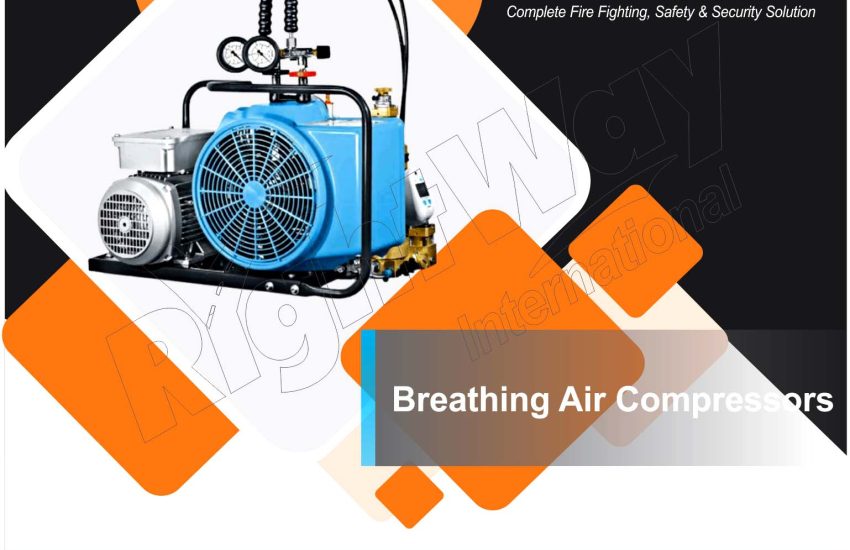Breathing air compressor play a critical role in generating and supplying compressed air for respiratory protection. Industries, emergency services, and other environments depend on these compressors to provide breathable air under pressure, ensuring personal safety.
1. Purpose and Importance
Breathing air compressors provide a reliable source of clean, breathable air to individuals using respiratory equipment, such as Self-Contained Breathing Apparatus (SCBA) or air-supplied respirators. They play an essential role in:
- Ensuring a continuous supply of breathable air in hazardous environments.
- Supporting emergency response operations effectively.
- Maintaining safe and healthy conditions in industrial settings.
Because of their vital function, these compressors contribute significantly to protecting workers and responders.
2. Components of Breathing Air Compressors
A typical breathing air compressor system consists of several key components working together:
Compressor Unit
This core component compresses ambient air to the required pressure. Depending on the application, compressors can be portable or stationary.
Air Filtration System
The filtration system removes contaminants like dust, oil, and moisture before compression. This step ensures the air meets strict purity standards for safe breathing.
Pressure Regulator
The pressure regulator controls the output pressure, delivering compressed air at the appropriate level for respiratory equipment.
Storage Tank
The storage tank holds compressed air for immediate use. Its size varies based on the system’s capacity and operational needs.
Cooling System
The cooling system prevents overheating by cooling the compressed air and compressor components, which maintains efficiency.
Control Panel
Operators use the control panel to monitor and adjust the compressor’s operation, including pressure levels and maintenance alerts.
3. Types of Breathing Air Compressors
Different types of compressors suit various operational environments:
Portable Compressors
Compact and mobile, these compressors serve field operations or locations where permanent installation is impractical. Emergency services and remote job sites frequently use them.
Stationary Compressors
Installed in fixed locations such as industrial plants or fire stations, stationary compressors provide a continuous, high-volume air supply.
Electric Compressors
Powered by electricity, these compressors are ideal where power is available and no explosion risk exists.
Gas-Powered Compressors
Operated by gasoline or diesel engines, gas-powered compressors offer mobility and function in areas without electrical power.
4. Applications
Breathing air compressors find use across multiple settings:
- Industrial Environments: Workers use SCBA or air-supplied respirators in hazardous settings like chemical plants, construction sites, and manufacturing facilities.
- Emergency Services: Firefighters and rescue teams rely on compressors for a dependable air supply during operations in smoke-filled or toxic atmospheres.
- Diving Operations: Surface-supplied diving equipment depends on compressors to provide continuous clean air underwater.
- Medical Facilities: Compressors supply clean, compressed air for medical equipment and respiratory therapy.
5. Maintenance and Care
Regular maintenance helps ensure compressors operate reliably:
- Regular Inspections: Conduct routine checks on the compressor unit, filtration system, and pressure regulator to detect issues early.
- Filter Replacement: Follow manufacturer recommendations to replace filters and consumable parts, maintaining air quality and performance.
- Cooling System Maintenance: Keep the cooling system functioning properly to avoid overheating and extend compressor life.
- Storage Tank Inspection: Inspect tanks periodically for wear, corrosion, or damage to prevent failures.
6. Safety Considerations
To guarantee safe operation, users should:
- Follow Safety Standards: Adhere to OSHA, NIOSH, and other relevant guidelines to ensure air quality and system safety.
- Ensure Air Quality: Regularly test compressed air for contaminants to meet purity requirements.
- Provide Training: Train operators on correct use, maintenance, and safety procedures associated with compressors.
7. Regulatory Compliance
Breathing air compressors must meet several regulatory requirements, including:
- Occupational Safety and Health Administration (OSHA)
- National Institute for Occupational Safety and Health (NIOSH)
- European Committee for Standardization (CEN)
- Compressed Gas Association (CGA)
Compliance with these standards ensures safety and reliability.
Conclusion
Breathing air compressors are indispensable for delivering a safe and reliable supply of breathable air in various settings. By understanding their components, applications, and maintenance needs, users can maximize efficiency and safety. Furthermore, consistent care, adherence to safety regulations, and proper training remain crucial to sustaining compressor performance and reliability.


